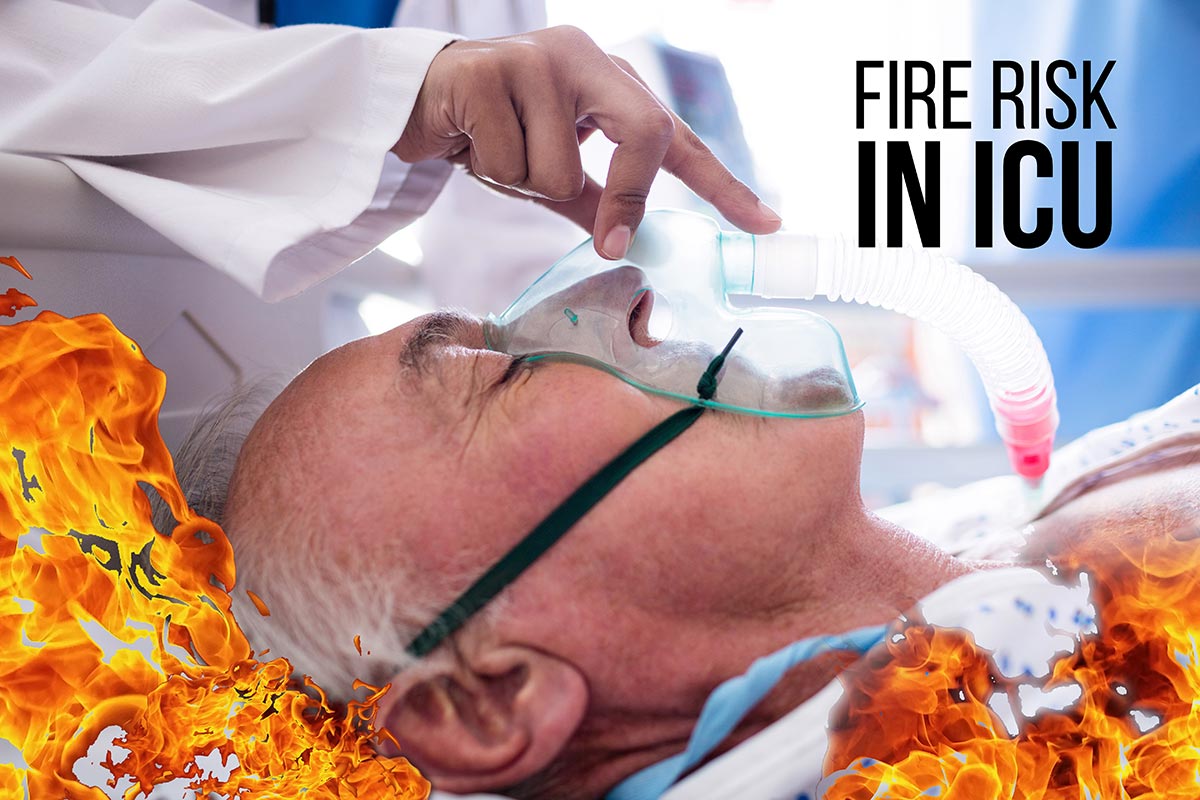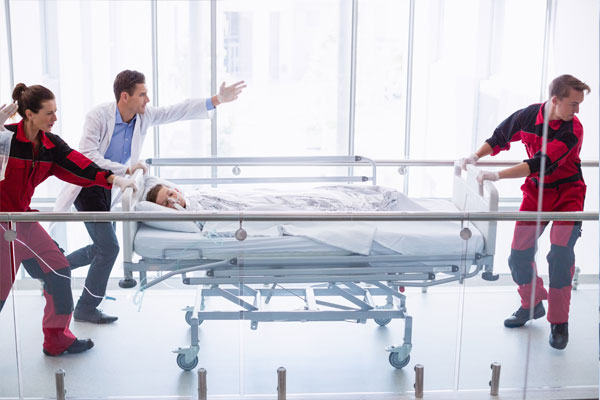Deepak Venkatesh Agarkhed
AVP-Sakra World Hospital
Ex-Technical committee member-NABH
Risk mitigation: Fire at Intensive Care Unit set-up

The ongoing pandemic has pointed out several loopholes in healthcare. Unfortunately, repeated fire incidents, especially in the ICU units, are becoming more frequent due to peak and continuous usage of all medical equipment especially non-safety certificated medical equipment in unsafe practice conditions.
Fire outbreaks in the ICUs not only endanger the patients but it puts the staff, the nearby chambers at high risk.
The following article is an attempt to spy on the causes and suggestive mitigations with the aid of a case study.
A case study:
A patient at the ICU needed to be resuscitated immediately from cardiac arrest and the intensivist pulled the crash cart and used a defibrillator to give desired electrical energy through paddles placed against the patient. The electrical spark arched from paddles to the patient as high impedance gel was mistakenly used. These sparks from the defibrillator ignited body hair spread to the linens i.e. patient gown, blanket resulting in a fire incident.
Several fire accidents are reported in ICU set-ups on account of many unsafe practices combined with insecure conditions like short-circuit in medical equipment, capacitor blasts in split air conditioning or ceiling fan, explosions in oxygen cylinders. Some of them even lead to the deaths of patients and staff. The clinical equipment employed to treat critical patients, unfortunately, is prone to an ignition source, whereas oxidizer and fuel are readily found in ICU to form the classic fire triangle.

A fire-friendly set-up:
Any ICU set-up in the hospital will have a patient space, a nurse station, medication and equipment storage, a linen room, and a staff lounge. Each patient needs at least a minimum space of 120 to 160 sq. feet to accommodate more or less ten electrical outlets, central oxygen, compressed air, and suction lines. The equipment may have a dialysis port to supply water inlet to the hemodialysis unit and water drain line too. Typically, six to eight pieces of medical types of equipment are connected to a patient round the clock based on the condition of the patient is treated in ICU. In an oxygen-rich environment of positive pressure, there is a high possibility of fire mishaps if institutional safety norms are not followed.
The probability of fire risk is heightened in the pandemic due to the extensive usage of alcohol-based hand sanitizer across ICU including the extensive use of disinfectant like sodium hypochlorite solution for cleaning surfaces and equipment. Though sodium hypochlorite is not combustible, it is a strong oxidizer that enhances the combustion of other materials like paper, PPE kits.
The repeated hospital fire mishaps across India, especially at ICUs, raise the question of a safe environment and safe work practice followed by the hospital staff.
Common mistakes made by hospital staff are the use of expansion boards to connect medical equipment, faulty medical or electrical equipment in use, medical equipment with electricity or power points in the vicinity of IV fluids. Hazardous substances such as disinfectant chemicals, oxygen cylinders are kept in an unsafe condition and the storage area is disposed of with unwanted items. Older X-ray films of patients are sensitive to fire hazards.
The root causes for major ICU fire mishaps mainly identified are :
- Inadequate hospital design in terms of electrical power load
- Incomplete civil work on hospital project handover of fire infrastructure barricading compartmentalization
- No consideration towards smoke evacuation management system for centrally air-conditioned hospital
- No consideration towards future upgradability /expansion of the clinical facility
- Untrained/inadequate trained staff on fire safety practices
- Bypassing electrical safety norms by engineering staff
- Inadequate maintenance on fire infrastructure, electrical utilities, and medical equipment.

How to foolproof the ICU ?
The National Disaster Management Guidelines on Hospital Safety (click here to download Fire Safety Audit Check List) expects the hospitals to have reasonable degrees of medical certainty from fire emergencies in hospitals. This can be achieved through better design and construction. The hospital must be well equipped with fire detection & alarm systems, with adequate provision of fire extinguishing devices.
The staff too has to be well trained to perform isolation and transfer to safety. They must be well versed with the evacuation protocols to direct patients and occupants to a safe location outside the hospital during a fire outbreak.
Engineering solutions:
The engineering team should ensure that overloading of existing power cables is avoided whenever a new power requirement for additional equipment arises. MCB and ELCB should be provided for an electrical circuit to avoid short circuits.
Hospital authorities must prominently display SMOKING BAN inside the premises of the hospital especially near oxygen storage, LPG bank, and diesel storage yard. It is better to remove all the curtains and any other easily combustible material near air-conditioners and service panels containing electrical outlets in the inpatient space.

Staff coordination
The emphasis should be on risk identification, mitigation, and team approach. A team of nurses, clinicians, engineers, and fire officers can come together to propose and execute strategies.
It is necessary to conduct regular fire drills for field personnel and inspection of facilities. It is very important to routinely inspect the facility and control fire safety standards. The central control unit must be vigilant and run checks on ICU units at all times.
Different survival and prevention strategies :
In case of fire incidents, a detailed incident analysis needs to be carried out to identify the root causes so that fire policy, infrastructure maintenance, staff training, and simulation exercises can be reviewed.

Standardized procedure of 3-pronged strategy:
The three-pronged strategy of 2 S + FMEA + Work instruction training is a must for reducing fire risk.
- The adoption of efficient workplace utilization using 2 S is to sort out clearly needed items from unnecessary items for immediate retrieval in clinical area.
- Reviewing risk score using the failure mode effective analysis (FMEA) on ICU fire management to mitigate most of the high-risk activities by the hospital safety team.
- Repeated field staff training on work instruction on fire risk management.
The first approach towards the intensive care fire incident is to protect patients, staff, and assets, manage fire hazards, identify the cause, and prevention.
The management of fire hazards should be as early as possible as in most fire incidents. Within few seconds thick smoke will spread across the construction impairing visibility.

The RACER :
This method is suggested to be adopted in case of fire.
Rescue phase involves the removal of all patients and staff from immediate danger areas with safe disconnection of lines, monitoring, and equipment.
Clert phase involves the activation of fire alarms and establishes quick communications with designated fire offices.
Extinguish involves the use of appropriate extinguishers (CO2 and dry powder) and fire blankets.
Relocate phase deals with the safe evacuation of both stable & unstable patients and visitors to the assembly area.
Patients have the right to be treated in a safe environment in a hospital. With the current Covid pandemic situation, fire safety is very important for intensive care set-up having peak load both to the patient and deployed staff.
